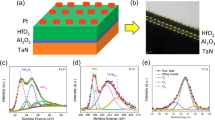Abstract
Organic memristive device based on polyaniline emeraldine base–polyethylene oxide was fabricated. Cyclic voltage–current characteristics of the device, measured at different acquisition rate, revealed the transformation of the linear behavior at high scanning rate through the curves with the pronounced hysteresis loop at the middle rate values and finally to the characteristics, suitable for the utilization of the device in synapse-mimicking circuits.




Similar content being viewed by others
References
Hebb, D. O. (1961). The organization of behavior. A neuropsychological theory. Second Edition. New York: Wiley and Sons.
Chua, L. (1971). Memristor—the missing circuit element. IEEE Transactions Circuit Theory, 18, 507.
Strukov, D. B., Snider, G. S., Stewart, D. R., Williams, R. S. (2008). The missing memristor found. Nature, 453, 80.
Erokhin, V., Berzina, T., Fontana, M. P. (2005). Hybrid electronic device based on polyaniline-polyethylene oxide junction. Journal of Applied Physics, 97, 064501.
Berzina, T., Smerieri, A., Bernabo, M., Pucci, A., Ruggeri, G., Erokhin, V., et al. (2009). Optimization of an organic memristor as an adaptive memory element. Journal of Applied Physics, 105, 124515.
Erokhin, V., Berzina, T., Camorani, P., Smerieri, A., Vavoulis, D., Feng, J., et al. (2011). Material memristive device circuits with synaptic plasticity: learning and memory. BioNanoScience, 1, 24–30.
Erokhin, V., Berzina, T., Fontana, M. P. (2007). Polymeric elements for adaptive networks. Crystallography Report, 52, 159.
Kang, E. T., Neoh, K. G., Tan, K. L. (1998). Polyaniline: a polymer with many interesting intrinsic redox states. Progress in Polymer Science, 23, 277.
Pershin, Y. V., & Di Ventra, M. (2011). Memory effects in complex materials and nanoscale systems. Advances in Physics, 60, 145.
Lokshin, N. A., Pyshkina, O. A., Golubev, V. B., Sergeyev, V. G., Zezin, A. B., Kabanov, V. A. (2001). Intermolecular electron transfer in low-weight polyaniline models associating on protonation by amphiphilic acid in organic solvent. Macromolecules, 34, 5480.
Ulman, A. (1991). An introduction to ultrathin organic films: from Langmuir–Blodgett to self-assembly. Boston: Academic.
Troitsky, V. I., Berzina, T. S., Fontana, M. P. (2002). Deposition of uniform conductive polyaniline films and approach for their patterning. Synthetic Metals, 129, 39–46.
Troitsky, V. I., Berzina, T. S., Fontana, M. P. (2002). Langmuir-Blodgett assemblies with patterned conductive polyaniline layers. Materials Science and Engineering, C 22, 239–244.
Berzina, T., Erokhina, S., Camorani, P., Konovalov, O., Erokhin, V., Fontana, M. P. (2009). Electrochemical control of the conductivity in an organic memristor: a time-resolved X-ray fluorescence study of ionic drift as a function of the applied voltage. ACS Applied Materials & Interfaces, 1, 2115.
Erokhin, V., & Fontana, M. P. (2011). Thin film electrochemical memristive systems for bio-inspired computation. Journal of Computational and Theoretical Nanoscience, 8, 313–330.
Acknowledgments
We acknowledge the financial support of the Future and Emerging Technologies (FET) program within the Seventh Framework Program for Research of the European Commission, under the FET-OPEN grant agreement BION, number 213219. Special thanks to Mr. Yuri Gunaza for his help in the preparation of figures.
Author information
Authors and Affiliations
Corresponding author
Rights and permissions
About this article
Cite this article
Gorshkov, K., Berzina, T. On the Hysteresis Loop of Organic Memristive Device. BioNanoSci. 1, 198–201 (2011). https://doi.org/10.1007/s12668-011-0021-6
Published:
Issue Date:
DOI: https://doi.org/10.1007/s12668-011-0021-6




